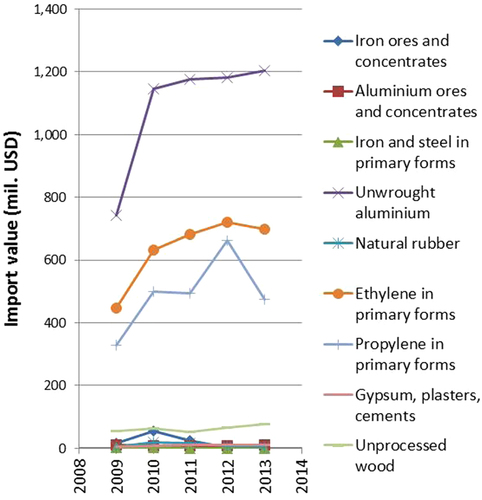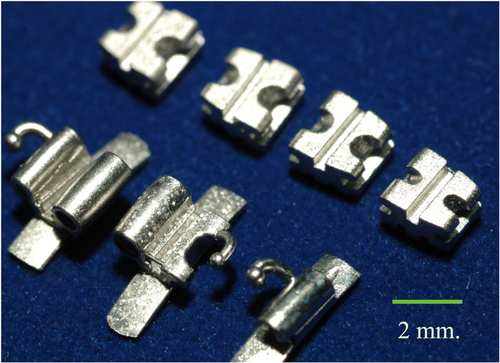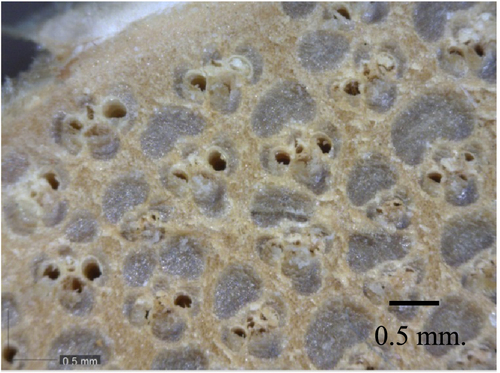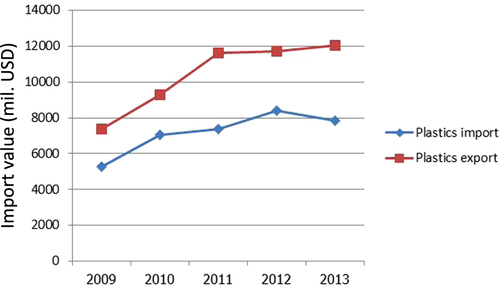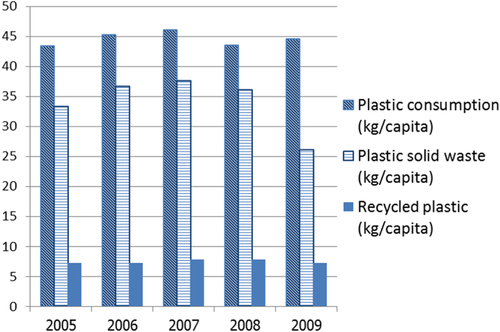Abstract
This article covers recent developments of material research in Thailand with a focus on environmental sustainability. Data on Thailand’s consumption and economic growth are briefly discussed to present a relevant snapshot of its economy. A selection of research work is classified into three topics, namely, (a) resource utilization, (b) material engineering and manufacturing, and (c) life cycle efficiency. Material technologies have been developed and implemented to reduce the consumption of materials, energy, and other valuable resources, thus reducing the burden we place on our ecological system. At the same time, product life cycle study allows us to understand the extent of the environmental impact we impart to our planet.
1. Introduction
Material science and engineering was one of the key success factors of the industrial revolution in the late eighteenth to early nineteenth century, which began in Great Britain [Citation1]. The revolution brought about a better living standard for the people at large but at the same time put more strain on our environment [Citation2, Citation3]. Coal-fired steam engines to drive transport and machinery, together with iron production and mechanical and thermal metal processing, led the way in both respects [Citation4]. Since that era our demand for manufactured products has not subsided. This demand is driven by population growth as well as advancements in technology, material science included. With continued global growth, demand will continue to grow. With our fast-moving high-tech lifestyle, demand continues to grow. In the last 20 years, the world population has increased by 26% but extraction of natural resources and food production has increased by more than 40% [Citation5]. All of this bodes poorly for our already deteriorating environment. As members of the global society and as material technologists, it is our duty to rise to this challenge and to protect our planet’s environment.
Environmental challenges faced by Thailand in many ways follow those of the global society: climate change, water crisis, food crisis, and energy stability. The complexity of their interdependence makes it impossible to consider them separately. We can tackle various issues at the national level, beginning with encouraging public awareness, establishing sustainable management systems, maintaining up-to-date product life cycle databases, etc. These are part of the framework required to allow a successful implementation of ‘environmentally less hostile’ technologies.
In terms of technological advancement, Thailand has focused its material research and development over the last 40 years largely on production efficiency. This includes resource utilization and energy expenditure. Thailand’s material intensity (material usage per GDP) has improved significantly (see figure ). This reduction in material intensity values suggests that from 1980 to 2008 Thailand showed significant improvement in making more efficient use of materials. However, when compared with other Asian countries in 2008, Thailand’s material intensity was still much higher than that of Japan and the Republic of Korea [Citation6]. The Asian financial crisis which started in 1997 is responsible for the marked decrease in material intensity values for many years that followed. As the situation recovered in 2003, material intensity increased with economic growth to approximately 4 kg/USD, whereas it continuously decreased to approximately 3 kg/USD in 2008.
Figure 1. Material intensity and ecological footprint among Asian countries [Citation6, Citation36].
![Figure 1. Material intensity and ecological footprint among Asian countries [Citation6, Citation36].](/cms/asset/bc41d34e-7797-4d0c-a4db-a5e01a2a96c6/tsta_a_11661283_f0001_oc.jpg)
The impact of Thai industries on the environment has been recognized by the government and has been included in the National Economic and Social Development plan since 2002, and it was included in the first National Science Technology and Innovation Policy and Planning document issued by the Ministry of Science and Technology of Thailand in 2012 [Citation7].
The National Metal and Materials Technology Center (MTEC), as a member of the National Science and Technology Development Agency (NSTDA), is a government-sponsored institute. MTEC plays a central role in material research and development in Thailand. Together with our partner institutes, universities, and funding agencies, we strive to reach the national goal of eco-efficiency and environmental sustainability of economic growth.
Under the theme of environmental protection, research at MTEC is focused on three main areas: (a) resource utilization, (b) material engineering and manufacturing, and (c) life cycle efficiency.
2. Resource utilization
Thailand does not produce many raw materials in large quantity apart from natural rubber, gypsum, and cement. The import figures show an increasing trend in imports of raw materials of several types, including aluminum and ethylene (see figure ). Our research and development concentrate on using these resources to their full potential. Some examples are given hereafter.
2.1. Powder metallurgy
Powder metallurgy (PM) is a good example of a processing technology where material resources can be used efficiently. In terms of resource utilization, PM processes produce parts with precise tolerances; hence machining steps and waste are greatly reduced. For high-volume production of small, high-precision components, PM can be a more economical and environmentally friendly process route when compared with other processing routes such as material removal or precision casting.
One advantage of the PM process over the traditional casting process is the wider range of microstructures that can be obtained. Powder preparation and post treatment can be used to manipulate structures, for example, the preparation of powder containing Cu6Sn5 intermetallic or CuO nanoparticles to obtain products with unique properties [Citation8, Citation9]. The development of compacting, sintering, and heat treatment techniques for new materials is also required to support the growth of PM in Thai industries [Citation10–Citation12].
Metal injection molding (MIM) as a branch of PM finds applications in the electronics and jewelry industries in Thailand. In MIM, a mixture of fine metal powder and binder is processed using injection molding. Understanding the rheology of the feedstock is vital for achieving a high-quality finished product. MIM of metals and alloys of high value such as Ni, Ti, and rare earth metals gains an economic edge due to the near-zero-waste concept. These elements are often scarce, and mining leads to disturbance of the natural landscape. Furthermore, use of indirect resources such as machine tools, chemicals, water, and energy can also be reduced. Work has been carried out to gain insight into MIM processes and to improve the processing parameters which will lead to a wider range of applications (see figure ) [Citation13–Citation15].
2.2. Rubber processing
Thailand produces its own latex and natural rubber and exports them in large quantities. To date, rubber plantations cover more than 20 million hectares, and their area is continuously growing in response to the global demand for natural rubber. Rubber is therefore one of the strategic research targets identified for the country. Much effort has been invested in increasing plantation yields, not only in terms of cultivars but also in terms of post-harvest processing. Increasing farm yield will eventually reduce the rate of deforestation. MTEC’s material research in post-harvesting includes work on prolonging the life and preserving the quality of latex, a high-efficiency coagulation process, and an eco-friendly coupling agent for rubber compounds [Citation16–Citation18].
2.3. Cement fillers and alternatives
Cement production is one of the largest producers of greenhouse gas among industrial sectors. It is also one of the fastest growing industrial sectors in Thailand. CO2 is released during the heating of calcium carbonate. The cement industry is responsible for approximately 5% of global industrial CO2 emissions [Citation19]. To reduce the impact of the industry, we need to slow the demand for cement. Work has been done on replacing some of the cement with fillers such as plant fibers, fly ash, and rice husk ash, with the added benefit that these fillers are often unwanted byproducts of other industries [Citation20, Citation21]. Parallel work is also under way on alkali-activated aluminosilicate-based geopolymer as a replacement for cement in construction. This material not only has the potential to replace conventional cement but can also make use of waste from coal-fired power plants [Citation22].
2.4. Natural materials
Wood remains a popular choice as a construction and household material. In furnishing, wood is preferred due to its conventionality, comfort, strength, and, in many cases, energy conservation. Bamboo is a fast-growing alternative to tree woods. A bamboo forest can be harvested after just three years of plantation. Well-managed bamboo farms trap a relatively high quantity of CO2 per hectare of managed forest area [Citation23]. Furthermore, in Asian culture bamboo shoots are also valued as a food source. The challenges in replacing traditional tree woods with bamboo involve chemical treatment against mold, pests, and discoloration as well as joining. Figure reveals the porosity of dry bamboo, which encourages the growth of biodegrading organisms. This area of research has recently been introduced at MTEC. We aim to replace some traditional woods with low-cost, low-life-cycle-cost bamboo.
3. Materials engineering and manufacturing
Thailand as a processing hub for automobile and electronics parts for the Southeast Asia region supports many research projects in materials engineering and processing. This research aims to achieve at least one of the following objectives: produce high-quality parts with longer life, thus reducing material consumption; minimize waste; or minimize energy consumption. Some of our projects are outlined in the following paragraphs.
3.1. Aluminum processing
Aluminum requires a large amount of energy in its purification process. This metal, however, is 100% recyclable. Recycling of aluminum generates a significant energy saving over the production of primary aluminum and helps to reduce the demand for landfills [Citation24]. Thailand produced approximately 2.5 million cars in 2012 [Citation25, Citation26]. On average each car uses approximately 70–100 kg of aluminum [Citation27]. Therefore, as much as 200 000 tons of aluminum in Thailand ended up in automotive parts. This is accountable for approximately 70% of the total use of aluminum in Thailand. The common defect rate of 5–7% found on the shop floors of cast houses and with other uses of aluminum brought the total consumption of aluminum in 2012 to 300 000 tons. Continuous process improvement and defect reduction programs along with process optimization are strongly advocated by automotive manufacturers to eliminate waste and minimize the consumption of energy. Processes such as squeeze casting and semi-solid casting of aluminum alloys provide alternatives for Thai industry to achieve high-quality products with lower waste and lower energy consumption [Citation28]. Consultation on material control and process optimization is offered to industries to encourage the use of secondary ingot, returns, and suitable scrap [Citation29]. This is also one of the areas where successful implementation is dependent on the public framework regarding the waste management system (collection, sorting, and recycling of scrap) being in place along with major players in the automobile field supporting the national policy.
3.2. Polymer engineering
Polymer engineering is another major contributor to the country’s GDP. Figure shows the growth of the import/export figures for polymer raw materials and polymer products. Polymers are featured prominently in our lives, from packaging to electronics. Research and development in polymer engineering have strong potential to create significant impacts not only on the economy but also on society in general and the environment. MTEC’s work in this field is focused on studies of polymer synthesis as well as reinforced polymers and their processing [Citation30–Citation32]. The information and technology gained from research and development with respect to process improvement and energy efficiency are made available to industries via seminars, training programs, and local publications.
3.3. Surface engineering
Surface engineering enhances the performance of a component. It enables the use of cheaper, more abundant materials in demanding applications. Surface engineering can also prolong the lifetime of products, thus reducing the use of natural resources in the long term. Surface techniques such as carburization, electroplating, thermal spraying, and physical vapor deposition serve a wide range of industries such as jewelry, agriculture, electronics, automobiles, and power generation. Our research priority has been on wear-resistant and corrosion-resistant applications to increase the reliability of components [Citation33, Citation34]. The application of wear-resistant coatings and solid lubricant coatings has been successfully implemented in Thai industry. In addition to reducing the use of materials, a suitable coating application can help reduce the amount of energy required for operation due to reduction in friction [Citation35].
4. Life cycle efficiency
The human population currently consumes resources at a higher rate than the world can produce them. Biocapacity is a term that describes the capacity of our ecosystems to produce useful biological materials and to absorb waste materials using current technologies. Ecological footprint is a measure of the area of biologically productive land and water an individual requires to produce all the resources he/she consumes and to absorb the waste generated.
Figure shows an alarming trend in Thailand wherein the ecological footprint is continuously growing whereas Thailand’s biocapacity remains unchanged at just under 1.2 hectares per capita [Citation36]. A major change occurred around 1985, when Thailand underwent a gradual transition from an agrarian to an industrialized economy. The industrial boom in the region caused the ecological footprint to increase to almost double that in the pre-industrialization era. The Asian financial crisis that started in 1997 set back the country’s industrial activity significantly, which is evident as a drop in the ecological footprint. Since then, as the economy has recovered, the figure has also climbed back up. Even though the material intensity values in figure show a significant improvement in 2007 and 2008, the ecological footprint has maintained a relatively steady value at around 2.2–2.3 hectares per capita.
It is thus important that the use of resources be justified in every aspect of our lives if we are to reduce the gap between biocapacity and ecological footprint. In manufacturing, for instance, we need to assess every activity required to make a product, from digging up ore and extraction of petroleum compounds all the way to manufacturing and design, logistics, product uses, and end-of-life management.
4.1. Life cycle analysis
Life cycle analysis (LCA) assesses the ecological impact of a product from the beginning of production to the end of its life. It is often a matter of debate where a product’s life ends: up to the point when its useful life is finished, when it is upcycled into a new product, or when its waste is decomposed and absorbed back into the Earth? Assumptions need to be made to suit the context and the purpose for which the analysis was designed. A well-constructed LCA together with a comprehensive database allows well-informed decision making in various respects. From the manufacturing side, LCA can point out the hot spot in a production line. From the consumer side, it reveals any hidden cost, thus allowing the consumer to make an informed choice. At the national level, it can point out impending risk to the nation and allows some time to prepare a countermeasure. Work on LCA in Thailand focuses primarily on creating a practical database for materials processing and on implementation of LCA concepts in our industries [Citation37–Citation40].
4.2. Eco-design
A design process involves consideration of the cost and functionality of a product. An eco-design process puts emphasis on environmental impact, sometimes to the point where the reduction of impact becomes the goal of the activity. The task of an eco-designer is therefore to create an alternative product with the same function but with the lowest possible ecological cost. Research institutes, the education sector, and the private sector in Thailand are working together to promote the eco-design concept through training, consultations, and public events.
The successful development of eco-products such as electrical appliances and packaging requires a manufacturer’s full involvement in the start-up of these projects [Citation41]. National policy also plays a vital role in establishing interest in such a scheme. Thailand’s eco-car initiative is one such example. In 2007, Thailand’s Board of Investment (BOI) launched its first phase of the eco-car program, where incentives were offered for integrated car assembly and key parts manufacturing projects. Excise tax incentives were also offered by the Finance Ministry of Thailand to foster domestic demand. This program succeeded in involving key manufacturers and attracting foreign investment to facilitate a new product. The second phase of the program, involving nine automakers, was approved in 2014. These automakers are required to commence production of new eco-cars by 2019.
4.3. Waste management
Paper and packaging materials are the largest contributors to household waste after food waste. Paper is currently routinely recycled, but only some plastics can be recycled economically (see figure ). Research has been carried out to study the recyclability of engineering polymers [Citation42]. Within the past 10 years, the rate of recycling of plastics per capita in Thailand has been approximately 16–17% [Citation43]. The remainder of the plastic waste is deposited in landfills. Biodegradable packaging is thus under development with the aim of replacing slow-disintegrating polymers such as polystyrene packaging [Citation44, Citation45]. To facilitate matters for the packaging industry and to stimulate public awareness, a bioplastic testing laboratory has also been established in Thailand.
5. Conclusion
The economy in the Southeast Asia region is expected to continue to grow, which will place more burden on our environment. Thailand has demonstrated success in reducing the waste and material intensity in processing, which is helping to improve resource expenditures. However, more data are needed to be able to show the full picture. Therefore, there is a clear need for an improved LCA database and continued research and development regarding the reduction of resource expenditures and the reduction of waste in materials processing. Such a refinement of current technologies is necessary, but it can have only limited scope. More drastic improvement requires a significant change in processing, and this highlights the need for research into alternative materials with lower ecological footprints, extension of a product’s useful life, and recycling technology to further reduce the impact of industry on the environment.
Environmental issues are already featured predominantly in Thailand’s national policy, which sets the industrial development trend toward more energy-efficient and resource-efficient practices. Because a large proportion of research projects in Thailand is government funded, such a policy is a major driving force for scientists and engineers to work together in finding sustainable solutions for the current human-related issues affecting our environment.
References
- HobsbawmE The Age of Revolution: Europe 1789–1848 Weidenfeld & Nicolson Ltd
- LucasR E Jr 2002 Lectures on Economic Growth Cambridge Harvard University Press 109 110 pp 109–10
- WoodwardD 1981 Wage rates and living standards in pre-industrial England Oxford J. Past & Present 91 28 46 28–46 10.1093/past/91.1.28
- RosenW 2012 The Most Powerful Idea in the World: A Story of Steam, Industry and Invention Chicago, IL University of Chicago Press p 149
- WWF 2012 The Living Planet Report 2012 Special Edition—On the Road to Rio+20
- CSIRO and UNEP Asia-Pacific Material Flows online database, ‘Recent trends in material flows and resource productivity in Asia and the Pacific’, © 2013 United Nations Environment Programme (2013)
- The first National Science Technology and Innovation Policy and Planning (www.sti.or.th)
- TongsriRYotkaewTKrataitongRWilaPSir-onAMuthitamongkolPTosangthumN 2013 Characterization of Cu6Sn5 intermetallic powders produced by water atomization and powder heat treatment Mater. Charact. 86 167 176 167–76 10.1016/j.matchar.2013.09.013
- BuarodE 2015 Facile synthesis and characterization of tenorite nanoparticles from gas-atomized Cu powder Powder Technol. 269 118 126 118–26 10.1016/j.powtec.2014.08.052
- CoovattanachaiOTosangthumNMorakotjindaMYotkaewTDaraphanAKrataitongRVetayanugulBTongsriR 2007 Performance improvement of P/M 316L by addition of liquid phase forming powder Mater. Sci. Eng. A 445–46 440 445 440–5 10.1016/j.msea.2006.09.105
- WorauaychaiNPoolthongNTongsriR 2013 Reduction of liquid phase formation temperature of TiC–Ni composite by sintering activator addition Powder Technol. 246 478 486 478–86 10.1016/j.powtec.2013.05.008
- ManonukulASaleeA 2013 Relationship between atmospheric dew point and sinterability of Al–Si based alloy J. Mater. Sci. Technol. 29 70 76 70–6 10.1016/j.jmst.2012.11.010
- ManonukulAMuenyaNLéauxFAmarananS 2010 Effects of replacing metal powder with powder space holder on metal foam produced by metal injection moulding J. Mater. Process. Technol. 210 529 535 529–35 10.1016/j.jmatprotec.2009.10.016
- WongpanitPKhanthsriSPuengboonsriSManonukulA 2014 Effects of acrylic acid-grafted HDPE in HDPE-based binder on properties after injection and debinding in metal injection molding Mater. Chem. Phys. 147 238 246 238–46 10.1016/j.matchemphys.2014.04.035
- KanchanomaiCSaengwichianBManonukulA 2009 Delamination wear of metal injection moulded 316L stainless steel Wear 267 1665 1672 1665–72 10.1016/j.wear.2009.06.019
- SiriwongCSae-OuiPSirisinhaC 2014 Comparison of coupling effectiveness among amino-, chloro-, and mercapto silanes in chloroprene rubber Polym. Test. 38 64 72 64–72 10.1016/j.polymertesting.2014.07.003
- PattanawanidchaiSLoykulnantSSae-ouiPManeevasNSirisinhaC 2014 Development of eco-friendly coupling agent for precipitated silica filled natural rubber compounds Polym. Test. 34 58 63 58–63 10.1016/j.polymertesting.2014.01.002
- KongkaewCDokkhanCPattanawanidchaiSChaikumpollertOLoykulnantS 2012 Factors affecting creaming efficiency of bio-based polymers, vulcanization and mechanical properties of creamed skim rubber Biomass and Bioenergy 46 233 241 233–41 10.1016/j.biombioe.2012.08.021
- World Business Council for Sustainable Development 2002 The Cement Sustainability Initiative: Progress Report
- WansomSJanjaturaphanS 2013 Evaluation of fiber orientation in plant fiber-cement composites using ac-impedance spectroscopy Cement Concrete Res. 45 37 44 37–44 10.1016/j.cemconres.2012.11.003
- WansomSJanjaturaphanSSinthupinyoS 2010 Characterizing pozzolanic activity of rice husk ash by impedance spectroscopy Cement Concrete Res. 40 1714 1722 1714–22 10.1016/j.cemconres.2010.08.013
- TimakulPHemraKAungkavattanaP 2014 Effect of curing time on the compressive strength of fly ash-based geopolymer material The Int. Advances in Applied Physics and Materials Science Congress & Exhibition 24–27 Turkey
- YipingLYanxiaLBuckinghamKHenleyGGuomoZ 2010 Bamboo and climate change mitigation: a comparative analysis of carbon sequestration INBAR Technical Report No. 32 (Beijing: International Network for Bamboo and Rattan)
- International Aluminium Institute 2009 Global Aluminium Recycling: A Cornerstone of Sustainable Development
- Thailand Automotive Institute (www.thaiauto.or.th)
- FOURIN Inc. (www.fourin.com)
- ‘Lightweight Potential of an Aluminium Intensive Vehicle’ By FORSCHUNGSGESELLSCHAFT KRAFTFAHRWESEN mbH AACHEN sponsored by European Aluminium Association
- PhongphisutthinanCTezukaHSatoT 2011 Semi-solid microstructure control of wrought Al-Mg-Si based alloys with Fe and Mn additions in deformation-semi-solid-forming process Mater. Trans. 52 834 841 834–41 10.2320/matertrans.L-MZ201119
- LimmaneevichitrCEidhedW 2005 Effect of flux compositions on grain refinement in Al-Si-Mg alloy Light Metals 2005 Halvor KvandeTMS The Minerals, Metals and Materials Society
- AussawasathienDSahasithiwatSMenbangpungLTeerawattananonC 2011 Poly(o-anisidine)–polystyrene composite fibers via electrospinning process: surface morphology and chemical vapor sensing Sensors and Actuators B: Chemical 151 341 350 341–50 10.1016/j.snb.2010.07.048
- JarusuwannapoomTHongrojjanawiwatWJitjaichamSWannatongLNithitanakulMPattamapromCKoombhongsePRangkupanRSupapholP 2005 Effect of solvents on electro-spinnability of polystyrene solutions and morphological appearance of resulting electrospun polystyrene fibers Eur. Polym. J. 41 409 421 409–21 10.1016/j.eurpolymj.2004.10.010
- PetchsukAKlinsukhonWSirikittikulDPrahsarnC 2012 Parameters affecting transition temperatures of poly(lactic acid-co-polydiols) copolymer-based polyester urethanes and their shape memory behavior Polym. Adv. Technol. 23 1166 1173 1166–73 10.1002/pat.2017
- NiranatlumpongPKoiprasertH 2011 Phase transformation of NiCrBSi–WC and NiBSi–WC arc sprayed coatings Surf. Coat. Technol. 206 440 445 440–5 10.1016/j.surfcoat.2011.07.057
- NiranatlumpongPKoiprasertH 2006 Improved corrosion resistance of thermally sprayed coating via surface grinding and electroplating techniques Surf. Coat. Technol. 201 737 743 737–43 10.1016/j.surfcoat.2005.12.026
- NiranatlumpongPKoiprasertH 2010 The effect of Mo content in plasma-sprayed Mo-NiCrBSi coating on tribological behavior Surf. Coat. Technol. 205 483 489 483–9 10.1016/j.surfcoat.2010.07.017
- Global Footprint Network (www.footprintnetwork.org)
- SiangjaeoSGheewalaSHUnnanonKChidthaisongA 2011 Implications of land use change on the life cycle greenhouse gas emissions from palm biodiesel production in Thailand Energy for Sustainable Development 15 1 7 1–7 10.1016/j.esd.2011.01.002
- TongpoolRPhanichavalitNYuvaniyamaCMungcharoenT 2012 Improvement of the environmental performance of broiler feeds: a study via life cycle assessment J. Cleaner Production 35 16 24 16–24 10.1016/j.jclepro.2012.05.007
- TongpoolRJirajariyavechAYuvaniyamaCMungcharoenT 2010 Analysis of steel production in Thailand: environmental impacts and solutions Energy 35 4192 4200 4192–200 10.1016/j.energy.2010.07.003
- PapongSRotwiroonPChatchupongTMalakulP 2014 Life cycle energy and environmental assessment of bio-CNG utilization from cassava starch wastewater treatment plants in Thailand Renew. Energy 65 64 69 64–9 10.1016/j.renene.2013.07.012
- MungcharoenT 2005 Application of life cycle assessment and EcoDesign for Eco-product development in Thailand: case study for Eco-compressor Proc., Capacity Building on Life Cycle Assessment in APEC Economies Bangkok, Thailand 43 46 pp 43–6
- Sae-OuiPSirisinhaCSa-nguanthammarongPThaptongP 2010 Properties and recyclability of thermoplastic elastomer prepared from natural rubber powder (NRP) and high density polyethylene (HDPE) Polym. Test. 29 346 351 346–51 10.1016/j.polymertesting.2009.12.010
- The Pollution Control Department, Thailand (www.pcd.go.th)
- LeejarkpaiTSuwanmaneeURudeekitYMungcharoenT 2011 Biodegradable kinetics of plastics under controlled composting conditions Waste Manage. 31 1153 1161 1153–61 10.1016/j.wasman.2010.12.011
- Suchao-inKKoombhongsePChirachanchaiS 2014 Starch grafted poly(butylene succinate) via conjugating reaction and its role on enhancing the compatibility Carbohydrate Polymers 102 95 102 95–102 10.1016/j.carbpol.2013.11.001

